Posted on June 14, 2023 in ASRC News, Environmental Sciences Initiative

A National Science Foundation grant will help an ASRC-led multi-institutional team track and quantify how plastics break down in the environment
More than 25 million metric tons of plastic end up in the Earth’s soil every year, and how those plastics degrade can have major impact on the environment, plants, animals and humans. With the help of a $702,084 collaborative research grant from the National Science Foundation ($451,681 of which was awarded to the ASRC), a multi-institutional research team will address what is likely to be one of the major environmental problems of the 21st century: the effects of microplastics. The team includes project leader Brian Giebel, director of the ASRC Environmental Science Initiative’s Advanced Laboratory for Chemical and Isotopic Signatures, and professors Benjamin Bostick from Columbia University and Rich Gross from Rensselaer Polytechnic Institute.
“Whether they’re made from petroleum-based or bio-based materials, all discarded plastics that end up in the environment are broken down into microplastics that can find their way into our soil, water and air,” said Giebel. “Our team is attempting to distinguish and document how plastics breakdown in soils and interact with soil minerals and microbes. We also want to quantify their rates of decomposition and understand the impacts plastics may have on the soil environment and its native microbiome.”
The team will use carbon isotope tags, which are naturally inherent or artificially introduced into plastics, to monitor and trace their breakdown in soils and potential incorporation into soil microbial biomass. Using stable isotopes is an ideal approach to reliably confirm if environmental microbes directly or indirectly assimilate plastic materials. The team’s study has the potential to reframe the role of plastics in the current carbon cycle by defining their potential to alter soil carbon stocks and interfere with the natural emission of climate warming gases like carbon dioxide and methane.
The project will also provide opportunities for high school, undergraduate and graduate students to be involved with the research and understand the fate of these materials in soils around New York City. More fundamentally, Giebel says, students will also gain experience across geochemistry, analytical chemistry, and polymer/green chemistry—three increasingly related fields for solving the plastic pollution crisis.
